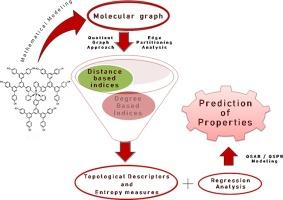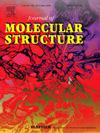铱芯树枝状聚合物的拓扑特征、熵度量和特性预测
IF 4
2区 化学
Q2 CHEMISTRY, PHYSICAL
引用次数: 0
摘要
本研究对以 Inmlr;n≥1 表示的铱核树枝状聚合物进行了全面的结构分析,重点采用基于度和距离的度量来阐明其结构-性质关系。树枝状聚合物以其高度支化的结构而闻名,是一种用途广泛的大分子,在各个科学领域都有应用。在这项工作中,分子描述符是重要的数字指标,可捕捉键合特征并帮助预测材料特性。利用新颖的商图方法,我们计算了一系列基于距离的指数,包括维纳(W)指数、塞格德(Sz 和 Sze)指数、莫斯塔尔(Mo 和 Moe)指数和帕德马卡-伊万(PI)指数。我们进一步推导出了与基于度数的指数相关的熵度量(如香农熵)的广义表达式,为评估这些化合物的结构复杂性提供了一个稳健的框架。此外,我们还研究了具有熵度量的各种基于度的描述符,包括萨格勒布指数(M1、M2 和 HM)、谐波指数(H)、遗忘指数(F)、兰迪克指数(R 和 RR)、ABC 指数、GA 指数、SC 指数、σ 指数和不规则指数(irr)。通过线性回归分析,我们建立了树枝状聚合物特性模型,并预测了后代的属性,从而最大限度地减少了大量实验室实验的需要。我们的研究结果为了解铱核树枝状聚合物分子的复杂性提供了宝贵的见解,为理论化学与实际应用架起了桥梁,并为材料科学与工程学的未来发展做出了贡献。本文章由计算机程序翻译,如有差异,请以英文原文为准。

Topological characterization, entropy measures and prediction of properties of Iridium cored dendrimer
This study presents a comprehensive structural analysis of Iridium-cored dendrimers, denoted by , with an emphasis on degree and distance based metrics to elucidate their structure-property relationships. Dendrimers, known for their highly branched architectures, are versatile macromolecules with applications across various scientific fields. In this work, molecular descriptors serve as essential numerical indicators, capturing bonding characteristics and aiding in the prediction of material properties. Leveraging a novel quotient graph approach, we compute a range of distance based indices, including the Wiener (W), Szeged (Sz and ), Mostar (Mo and ), and Padmakar-Ivan (PI) indices. We further derive generalized expressions for entropy measures associated with degree based indices, such as Shannon's entropy, providing a robust framework for assessing the structural complexity of these compounds. Additionally, we examine various degree based descriptors with entropy measures—including the Zagreb (, , and HM), Harmonic (H), Forgotten (F), Randic (R and RR), ABC, GA, SC, σ, and Irregularity indices (irr). A linear regression analysis is conducted to model dendrimer properties and forecast attributes for subsequent generations, potentially minimizing the need for extensive laboratory experimentation. Our findings provide valuable insights into the molecular intricacies of Iridium-cored dendrimers, bridging theoretical chemistry with practical applications and contributing to future advancements in materials science and engineering.
求助全文
通过发布文献求助,成功后即可免费获取论文全文。
去求助
来源期刊

Journal of Molecular Structure
化学-物理化学
CiteScore
7.10
自引率
15.80%
发文量
2384
审稿时长
45 days
期刊介绍:
The Journal of Molecular Structure is dedicated to the publication of full-length articles and review papers, providing important new structural information on all types of chemical species including:
• Stable and unstable molecules in all types of environments (vapour, molecular beam, liquid, solution, liquid crystal, solid state, matrix-isolated, surface-absorbed etc.)
• Chemical intermediates
• Molecules in excited states
• Biological molecules
• Polymers.
The methods used may include any combination of spectroscopic and non-spectroscopic techniques, for example:
• Infrared spectroscopy (mid, far, near)
• Raman spectroscopy and non-linear Raman methods (CARS, etc.)
• Electronic absorption spectroscopy
• Optical rotatory dispersion and circular dichroism
• Fluorescence and phosphorescence techniques
• Electron spectroscopies (PES, XPS), EXAFS, etc.
• Microwave spectroscopy
• Electron diffraction
• NMR and ESR spectroscopies
• Mössbauer spectroscopy
• X-ray crystallography
• Charge Density Analyses
• Computational Studies (supplementing experimental methods)
We encourage publications combining theoretical and experimental approaches. The structural insights gained by the studies should be correlated with the properties, activity and/ or reactivity of the molecule under investigation and the relevance of this molecule and its implications should be discussed.
 求助内容:
求助内容: 应助结果提醒方式:
应助结果提醒方式:


